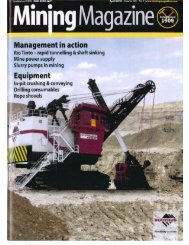clamp-on, sonar-based volumetric flow rate and gas ... - CiDRA
clamp-on, sonar-based volumetric flow rate and gas ... - CiDRA
clamp-on, sonar-based volumetric flow rate and gas ... - CiDRA
You also want an ePaper? Increase the reach of your titles
YUMPU automatically turns print PDFs into web optimized ePapers that Google loves.
Flomeko 2005<br />
6 – 9 June 2005<br />
distributed al<strong>on</strong>g the pipe outer circumference. The s<strong>on</strong>ar-<strong>based</strong> algorithms determine the<br />
speed of eddies by characterizing both the temporal <strong>and</strong> spatial frequency characteristics of<br />
the <strong>flow</strong> field. For a train of coherent eddies c<strong>on</strong>vecting past a fixed array of sensors, the<br />
temporal <strong>and</strong> spatial frequency c<strong>on</strong>tent of pressure fluctuati<strong>on</strong>s are related through the<br />
following relati<strong>on</strong>ship:<br />
kv<br />
(2).<br />
Here is the wave number, defined as k=2π/λ (1/m), ω is the temporal frequency (rad/s) <strong>and</strong> v<br />
is the c<strong>on</strong>vective velocity of the unsteady pressure fluctuati<strong>on</strong>s. Thus, the shorter the<br />
wavelength is the larger k <strong>and</strong> the higher the temporal frequency.<br />
In s<strong>on</strong>ar array processing, the spatial<br />
- temporal frequency c<strong>on</strong>tent of time<br />
stati<strong>on</strong>ary sound fields are often<br />
displayed using “k-w plots”. k-w plots<br />
are essentially two dimensi<strong>on</strong>al<br />
power spectra in which the power of<br />
a pressure field is decomposed into<br />
bins corresp<strong>on</strong>ding to specific spatial<br />
wave numbers <strong>and</strong> temporal<br />
frequencies. On a k-w plot, the power<br />
associated with a pressure field<br />
c<strong>on</strong>vecting with the <strong>flow</strong> is distributed<br />
in regi<strong>on</strong>s which satisfy the<br />
dispersi<strong>on</strong> relati<strong>on</strong>ship developed<br />
above. This regi<strong>on</strong> is termed the<br />
“c<strong>on</strong>vective” ridge 7 Figure 3: k-w plot showing c<strong>on</strong>vective ridge<br />
<strong>and</strong> the slope of this<br />
ridge <strong>on</strong> a k-w plot indicates the c<strong>on</strong>vective velocity of the pressure field. This suggests that<br />
the c<strong>on</strong>vective velocity of turbulent eddies, <strong>and</strong> hence <strong>flow</strong> <strong>rate</strong> within a pipe, can be<br />
determined by c<strong>on</strong>structing a k-w plot from the output of a phased array of sensors <strong>and</strong><br />
identifying the slope of the c<strong>on</strong>vective ridge. Figure 3 shows an example of a k-w plot<br />
gene<strong>rate</strong>d from a phased array of transducers listening to a 16 inch pipe <strong>flow</strong>ing water at<br />
approximately 350 l/s. The power c<strong>on</strong>tours show a well-defined c<strong>on</strong>vective ridge. A<br />
parametric optimizati<strong>on</strong> method was used to determine the “best” line representing the slope<br />
of the ridge. For this case, a slope of 3.2 m/s was determined. The intermediate result of the<br />
optimizati<strong>on</strong> procedure is displayed in the insert, showing that optimized value is unique <strong>and</strong><br />
c<strong>on</strong>stitutes of <strong>on</strong>e well-defined maximum.<br />
3.4 S<strong>on</strong>ar <strong>flow</strong> meter calibrati<strong>on</strong><br />
The k-w plot shown in Figure 3 illust<strong>rate</strong>s the fundamental principle behind s<strong>on</strong>ar <strong>based</strong> <strong>flow</strong><br />
measurements, namely that axial arrays of transducers can be used in c<strong>on</strong>juncti<strong>on</strong> with s<strong>on</strong>ar<br />
processing techniques to determine the speed at which naturally occurring turbulent eddies<br />
c<strong>on</strong>vect within a pipe. The next issue is to quantify the relati<strong>on</strong>ship between speed of the<br />
turbulent eddies <strong>and</strong> the <strong>volumetric</strong>ally averaged <strong>flow</strong> <strong>rate</strong> within the pipe.<br />
To quantitatively evaluate this relati<strong>on</strong>ship, a number of geometrically similar s<strong>on</strong>ar <strong>flow</strong><br />
meters with diameters between 4 <strong>and</strong> 16 inch were tested with water at a <strong>flow</strong> meter<br />
calibrati<strong>on</strong> facility for <strong>flow</strong>s ranging from 1.5 to 1500 l/s. The c<strong>on</strong>vecti<strong>on</strong> velocity determined<br />
using the s<strong>on</strong>ar-<strong>based</strong> techniques, normalized by the <strong>volumetric</strong>ally averaged <strong>flow</strong> <strong>rate</strong><br />
supplied by the calibrati<strong>on</strong> facility as a functi<strong>on</strong> of Reynolds number ranged between 99% <strong>and</strong><br />
102% of the <strong>volumetric</strong>ally averaged <strong>flow</strong> <strong>rate</strong> over the entire range of the test. A low-order<br />
Reynolds number <strong>based</strong> calibrati<strong>on</strong>, was developed from this data for this class of meters.<br />
The calibrati<strong>on</strong> equati<strong>on</strong> is developed in terms of the relative offset of the s<strong>on</strong>ar <strong>based</strong> meter<br />
from the reference meter. The relative offset Δ is, in terms of the Reynolds number Re <strong>and</strong> a<br />
set of three coefficients C1, C2 <strong>and</strong> C3, unique to each s<strong>on</strong>ar meter size given by (3).<br />
BI0197 RevB 4<br />
C2<br />
C1 <br />
(3).<br />
C3<br />
Re



